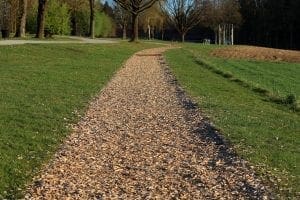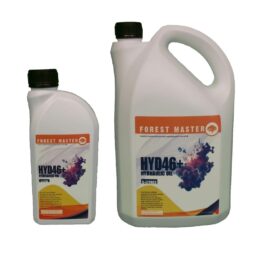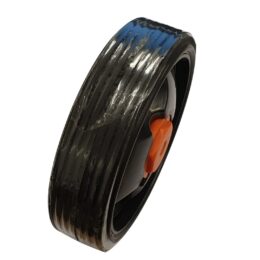Last Updated on February 23, 2021 by Forest Master
If you’re anything like me, the second you received your wood chipper you were eager to test it. Personally, I find watching a wood chipper extremely satisfying – I could sit and watch one go to town on a big pile of garden debris all day long.
If you’re anything like me though, you ended up with a large pile of wood chippings at the end, scratched your head and thought “well what am I supposed to do with all this?”.
We’ve all been there, no judgements. If you knew exactly what you could do with that big pile of wood chips though, you’d be amazed.
Quite frankly they’re a gardener’s dream, they’re extremely versatile and a cheap solution to a number of problems that many face in their garden at some point. Interested? Read on.
Wood Chip Mulch
If you haven’t already got a wood chipper, take a look at our wood chipper buying guide to find out which machine is best for you and your needs. If you think you can get all your gardening jobs done in one day, check out our article on the benefits of renting vs buying a wood chipper.
We’ll get the obvious one out of the way. Using wood chippings around your plants in the garden comes with a host of benefits, including providing excellent nutrition to your plants as they decompose.
Wood chippings are a staple element in making excellent compost, and simply by layering them on top you’re providing this to your plants.
Additionally, it helps regulate soil temperature by keeping your plants cool in summer and warm in winter due to the natural insulation it provides, as well as aeration.
And that’s not all. Wood chippings absorb water whilst providing shade to the top layer of soil, helping to also regulate moisture levels. This will help you prevent overwatering your plants and keep them moist for longer.
Weeds find it challenging to grow in the presence of wood chippings, so spreading chips on problem areas where weeds frequently grow is an easy and cheap solution to your problem.
Don’t be fooled into thinking it’s the miracle cure for everything though, there are some disadvantages that come with using wood chip mulch.
Chippings can cause a nitrogen deficiency in your top layer of soil, which is something that needs to be monitored if you want your plants to grow without problems.
Disease-prone plants such as roses and tomatoes can be easily overcome by fungal spores that like to grow inside the recesses of chippings, so don’t use them one planting beds if you’re unsure on the resilience of the plant first.
Best practices are to keep a small gap between your wood chips and the stem of your plants, allowing them to breathe and prevent fungal growth from killing your plants.
Wood Chipping Walkways

Walkways made from wood chippings are an excellent way to repurpose the produce of your wood chipper if you find yourself having an excessive amounts of the stuff.
Exceptionally quick and easy to make, and fantastic at keeping your boots free from mud, all you need to do is create a guide for your path and dump your wood chippings inside.
The chippings provide a natural drainage system for rain to filter in the ground, without creating a muddy top that you have to walk over.
It’s exceptionally easy to make curved paths using wood chippings which is much more difficult to achieve with pavers for example, and as already mentioned in the previous point will help prevent weeds from sprouting.
Obviously, these chippings will eventually begin to degrade, which means you will need to top them up every so often.
And to make the path initially, you’ll need quite a large quantity of chippings depending on the length of the path you’re creating, which are the two biggest downsides to this idea.
We recommend creating your path with at least 3 inches deep of wood chippings, though anywhere up to 6 inches is better.
Chips Make Excellent Compost
If you’re a fan of composting, which I imagine you are, then smaller sized chippings make excellent ‘brown material’ for making top quality compost.
Wood chippings are extremely carbon rich, a must have ingredient, along with nitrogen, needed to make quick and mineral intensive compost.
Be warned however, the chips do need to be as small as you can get them in order to break down faster, otherwise you’ll be looking at an unnecessarily elongated amount of time to create your compost, and nobody wants that.
You’ll also need to add an equal amount of green material in order to add nitrogen to the mix and balance out all that carbon.
Tips on creating the best compost possible can be found here.
Preventing Soil Erosion

If you’re a frequent sufferer of your nice clean lines being eroded by the elements, then you can comment and thank me for this ingenious solution.
Wood chippings make an excellent, albeit temporary, barrier for any areas of your lawn that are suffering from incessant erosion, ruining your hard-pruned nice clean lines.
Doing this will lead to your plants being healthier and stronger whilst simultaneously reducing the amount of spread of dirt around your lawn.
All you need to do is to till the wood chips into the soil to build up lower areas. The wood will absorb any excess moisture and help hold the ground firm until you can come up with a more permanent solution.
The thicker the layer, the more moisture it will absorb, and despite it compressing down it will still allow excess water to drain through without ruining your lines.
And once you have found a more permanent solution, you can rake up those wood chips and either add them to your compost pile or throw them on your chip path, so nothing goes to waste.
For the green-minded folks out there, it’s an excellent solution that minimises waste whilst maximises results.
Invasive Plant Growth? Not Anymore
If your property borders a wood or natural area, you can find that wild plants often encroach on your property.
Wood chips not only form a border that isn’t sore on the eyes, but are excellent at delineating lines that prevent the wild plants from growing onto your property.
You will need quite a large quantity for this, as the depth must reach the roots of the wild plants in order to stop the spread.
It is an excellent use of a large pile of wood chippings however and has seen excellent results from us in the past.
Enjoy this article? Check out some of our others.








Looking for any groups or individuals to make use of wood chippings for paths compost or soil retention etc , I can deliver and supply for free